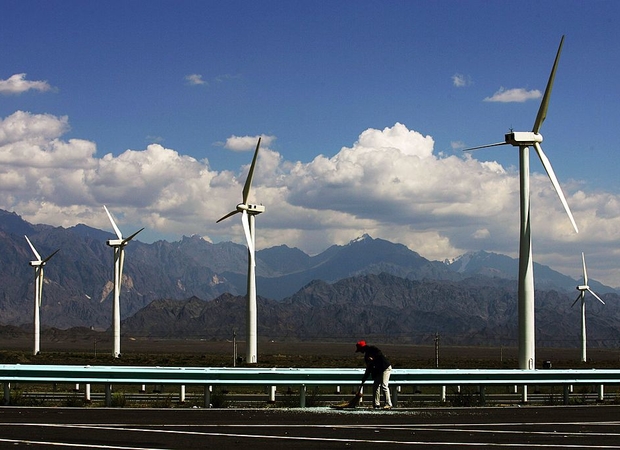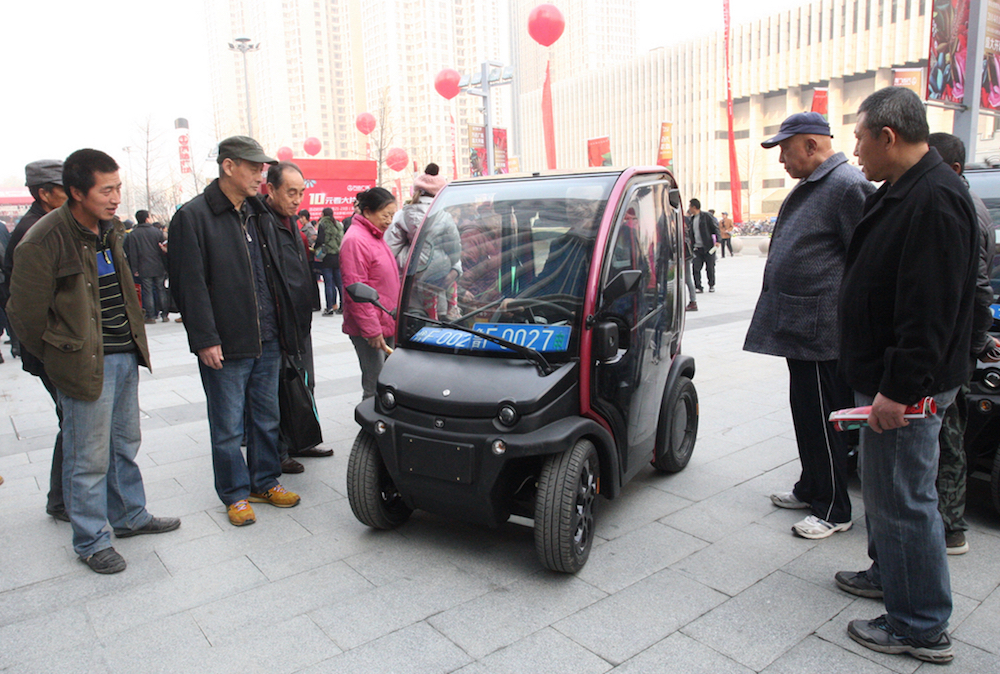For the last two years, Helen Ni has hosted low-carbon technology workshops for local kids and their parents. The informal gatherings take place at her ground-floor apartment in the Shanghai suburb of Minhang, close to Jiaotong University, one of the country’s foremost electric vehicle research centers.
Most classes take place outside on the beige-tiled patio, which stands out against her neighbor’s for its big wooden planters and brown ceramic pots that burst with greenery.
For many of the children, it’s their only opportunity to learn about planting while actually getting their hands dirty. They thrust their tiny fingers into the soil with glee while Niexplains what organic farming is and how you turn food waste into compost. In the corner of this unassuming rectangular space, there’s an aquaponics system to grow lettuce and flowers without the use of soil. It’s powered by fresh water and two 20-watt air pumps that draw their energy from the home solar panels above. Beneath the surface there are 20 small, busy fish that keep the artificial ecosystem healthy. It’s more of an urban oasis than a class room.
But Ni never set out to be a teacher. The idea to festoon her home with low-carbon technology came about piecemeal. It all started in 2013, with a solar-paneled patio roof. “It was climate change, really,” notes Ni with deliberate irony. “That summer was so hot in Shanghai that we couldn’t go outside. We needed shade to enjoy our new patio.” The Nis had heard about a new government scheme to support home solar projects. That’s when they came up with the notion of building a roof made out of solar panels.
“We had heard about a subsidy scheme that also lets you sell the surplus energy to the state grid. So I said, ‘Ok, let’s see if it is user-friendly or not,’” recalls Ni. After some calculations, Ni decided there were cost-benefits in investing in a solar roof that could also power their home versus a traditional awning which would need replacing annually (Shanghai has a typhoon season).
The next step was to get permission from the local residential committee and the property management company that run the complex. This came easily, as did support from the local government, which was keen to be seen as supportive of the new central government initiative. “The whole process of getting approval from the local government was hassle-free,” says Ni, who counted the local Party secretary among her first visitors.
Everything from the equipment to the scoping and installation service was ordered via a contact found through an alumni network. The hard part was finding a company that offered full installation, notes Ni. Now, there are hundreds operating in tier one and two cities across the country, thanks to China’s rapidly expanding logistics network.
Incentivizing Change
Surprisingly, Ni’s sustainable lifestyle has gained a strong following in her community. She was so inundated with inquiries and requests to see her unorthodox home that she had “no choice” but to set up a non-profit organization to teach people about low-carbon technology. The Shanghai Minhang Jiangchuan (Green Light-Year Environmental Service Center), launched in spring and so far has reached 1,500 people in the Minhang area.
“I realized that community-level demonstration facilities like this don’t really exist, ones that show people what low carbon development actually looks like; or what environmental protection and green lifestyle really means. The demand is there,” says Ni.
The project has revealed a new, upwardly-mobile type of consumer living in China’s first and second tier cities, who are keen to try new energy-saving technology that the government is advocating in response to rising pollution.
“Rampant consumerism among China’s fast-growing middle class has been the biggest barrier to changing people’s attitudes,” says Ni, who studied low-carbon technology development at Cambridge University in the United Kingdom before moving back to China. “At the same time, our traditional values of being frugal are vanishing,” she laments.
De-coupling notions of upward mobility and increased consumption will be crucial to China’s future prosperity. In the last three decades, the country has gone from being one of the world’s weakest economies to its second richest. Its rise has been based on a model of rapid industrial growth, manufacturing, and export. But now, that growth is slowing and China’s population is struggling to cope with polluted air, soil, and water. In response, the government has switched to a path of sustainable development and energy efficiency.
Its aims are ambitious. China’s latest five-year plan calls for a 15 percent reduction in energy consumption by 2020. It intends to do this by shifting the way people power their homes and vehicles from fossil fuels to electricity. Success will largely depend on altering public attitudes to consumption and incentivizing communities to adopt new energy efficiency standards.
Consumption Patterns
So what is the best way of changing consumer behavior?
“Economic incentives such as points, small gifts, and subsidies for solar plants, will make green consumption or green lifestyle more interesting for people and better-respected,” says Ni.
As in Europe and the U.S. before, feed-in-tariffs have been an effective driver of small-scale renewable- and low-carbon electricity generation across parts of the country.
In August 2013, China’s leaders introduced the first tariffs to support distributed solar rooftop installations. Consumers are entitled to a 20-year subsidy of 0.42 yuan (U.S.$0.06) per kilowatt-hour (kWh) of output from distributed PV rooftop projects. In addition, project owners receive about 0.43 yuan per kWh from the state grid for any extra power they generate.
Environment
10.17.16
Green Growth Could Boost China’s Economy Six-Fold
from chinadialogueMany cities in China offer additional subsidies to complement the state subsidies and further spur development of the solar PV sector. In Shanghai, the municipal government offers an additional 0.4 yuan per kWh over a five-year period.
In total, the Nis have spent around 31,000 yuan (including 7,000 yuan for stainless steel poles) to build their system so far. They receive about 2,100 per year through the subsidy scheme. Although the return on investment seems small, Ni believes that by continuing to support the renewables sector, government policy will have an impact.
The New Car Owner
However, the one policy responsible for the biggest shift in people’s day-to-day choices is the scheme to support electric vehicles (EVs), according to Ni. Last year, the Nis got together with some friends and teachers and set about buying a shared BYD electric vehicle.
Currently, a top brand pure EV, such as a Denza (a BYD and Mercedes-Benz joint venture) will set you back 300,000 yuan (U.S.$44,000). The average middle class citizen in Shanghai earns 219,770 yuan (U.S.$34,007). Shared ownership therefore makes buying these expensive cars affordable for most families.
The EV subsidy scheme offered additional financial benefits, too. It saved them 60,000 yuan on the purchasing cost, which was tax free. It also allowed them to get a highly-prized Shanghai number plate for free, whereas owners of traditional cars must enter a competitive and costly lottery system that can leave people waiting for years.
The rise of community-led car-buying cooperatives is one of the more interesting trends to emerge from the green lifestyle movement in China. In many burgeoning cities, the shared economy, facilitated by phone Apps such as Uber and Didi, has arrived before widespread car ownership. This is likely to have a profound impact on notions of car ownership, which are evolving separately from those in the West. In China, people may expect to drive a car one day, but may not expect to own it.
There is also the emergence of a new middle class aspiration that sees EVs as a status symbol. “They may not be able to afford a Tesla vehicle but people still want to flaunt their eco-credentials,” says Ni. EVs are still expensive, which may add to their social status value.
The growing appetite for information on renewable energy and how to apply it at home is striking. Now that government policies are in place, it is time to shine a light on the community leaders who are educating people on how to harness the new technology on the ground. As Ni says, “People want to learn but don’t know where to begin.”




